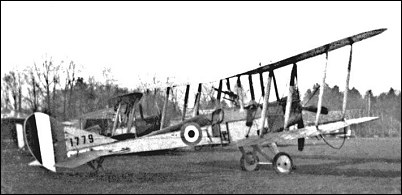|
| Second of the Farnborough designs to bear a "Bleriot
Experimental" designation as a general-purpose tractor
biplane, the B.E.2 appeared in 1912 and provided the
basis for a family of variants produced in large quantity
for use by the RFC, principally as an unarmed two-seat scout. With modifications to enhance the inherent
stability of the basic design, the B.E.2c was developed
in 1914 and many of the 1,216 of this variant built were to
serve with various ad hoc armament installations. The
B.E.2c was a two-bay biplane with unstaggered equispan
wings, a conventional tail unit with separate fin,
rudder, tailplane and elevators, and an undercarriage
incorporating skids to help prevent nose-overs. The
70hp Renault eight-cylinder Vee-type engine powered
early production aircraft, but the 90hp RAF la eightcylinder
Vee-type soon became standard. Construction
of the B.E.2c was of wood throughout, with fabric
covering. A variety of mounts was evolved for a single
7.7mm Lewis machine gun in the observer's
(front) cockpit, primarily for self-defence. More specifically
to serve as a fighter with Home Defence squadrons
of the RFC and the RNAS, numerous B.E.2c's were
modified as single-seaters, armament comprising a
single Lewis gun mounted to fire upwards behind the
wing centre section or, in some cases, on the side of the
fuselage alongside the cockpit, angled outwards to
clear the propeller disc. Flying by night, despite a lack
of nocturnal flight aids, B.E.2c's shot down five raiding
Zeppelins over the UK during 1916. B.E.2c's were also
used for a number of armament experiments.
 | A three-view drawing (1280 x 906) |
| WEIGHTS |
| Take-off weight | 972 kg | 2143 lb |
| Empty weight | 621 kg | 1369 lb |
| DIMENSIONS |
| Wingspan | 11.23 m | 37 ft 10 in |
| Length | 8.30 m | 27 ft 3 in |
| Height | 3.45 m | 11 ft 4 in |
| Wing area | 36.79 m2 | 396.00 sq ft |
| PERFORMANCE |
| Max. speed | 116 km/h | 72 mph |
| Klaatu83, e-mail, 20.09.2014 03:00 This aircraft has frequently been criticized in retrospect for a lack of maneuverability. However, what those critics fail to consider is that this airplane was designed before World War I began, and at the one of the principal considerations of it's design was positive stability. In that sense the designers succeeded, because the B.E.2c was certainly was a stable airplane. reply | | Frank Russell, e-mail, 12.01.2012 04:30 My father flew these as a pilot in the RFC & RAF in WW1 reply | | Angela, 21.06.2011 04:53 B.E.2c's were also used for a number of armament experiments. reply | | braden, e-mail, 08.06.2011 10:45 Do you still have the propeller boss? reply | |
| | yramesor@clear.net.nz, e-mail, 11.12.2006 04:51 Have in possession clock set into propeller boss with wording on the outer rim of the boss B.E.2.C. 100 hp RAF T5291 LONDON. Is this of significant interest? reply |
|
Do you have any comments?
|
| 
COMPANY
PROFILE
All the World's Rotorcraft
|







